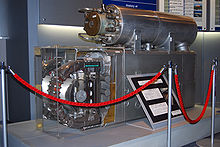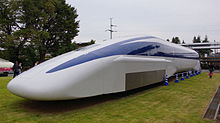SCMaglev
However, as the train runs on rubber wheels at relatively low speeds, the magnetic fields are positioned below the center of the coils, causing the electrical potential to no longer be balanced.
Because they are cross-connected underneath the guideway, if the train moves off-center, currents are induced into the connections that correct its positioning.
MLX01 trains were tested there from 1997 to fall 2011, when the facility was closed to extend the line to 42.8 km (26.6 mi) and to upgrade it to commercial specifications.
[8] In 2009, Japan's Ministry of Land, Infrastructure, Transport and Tourism decided that the SCMaglev system was ready for commercial operation.
In 2011, the ministry gave JR Central permission to operate the SCMaglev system on their planned Chūō Shinkansen linking Tokyo and Nagoya by 2027, and to Osaka by 2037.
[1] In 2013, Prime Minister Shinzō Abe met with U.S. President Barack Obama and offered to provide the first portion of the SC Maglev track free, a distance of about 40 miles (64 km).
[9] In 2016, the Federal Railroad Administration awarded $27.8 million to the Maryland Department of Transportation to prepare preliminary engineering and NEPA analysis for an SCMaglev train between Baltimore, Maryland, and Washington, D.C.[10] In late 2015, JR Central, Mitsui, and General Electric in Australia formed a joint venture named Consolidated Land and Rail Australia to provide a commercial funding model using private investors that could build the SC Maglev (linking Sydney, Canberra, and Melbourne), create eight new self-sustaining inland cities linked to the high-speed connection, and contribute to the community.







